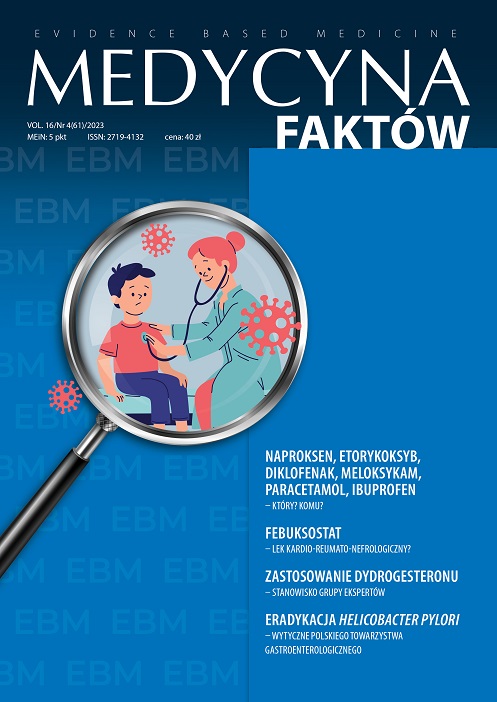DPP-4 inhibitors – facts and myths Review article
Main Article Content
Abstract
Dipeptidyl peptidase 4 inhibitors (DPP-4), known as gliptins, are a class of oral antidiabetic agents, indicated in treatment algorithm of type 2 diabetes mellitus (T2DM). The mechanism of DPP-4 inhibitors is to block dipeptidyl peptidase 4, increasing incretin levels – glucagon-like peptide 1 and glucose insulinotrophic peptide, leading to inhibition of glucagon release, increase of insulin secretion, decrease gastric emptying. According to recommendations of Polish Diabetes Society, DPP-4 inhibitors are used at the stage of intensification therapy of T2DM, or in monotherapy, when other antidiabetic agents are contraindicated. Sitagliptin and vildagliptin are widely available in Poland. Introduction of generic DPP-4 inhibitors and favourable refund conditions enabled wider access to medicines for patients.
Article Details
Copyright © by Medical Education. All rights reserved.
References
2. Davies MJ, Aroda VR, Collins BS et al. Management of hyperglycaemia in type 2 diabetes, 2022. A consensus report by the American Diabetes Association (ADA) and the European Association for the Study of Diabetes (EASD). Diabetologia. 2022; 65(12): 1925-66. http://doi.org/10.1007/s00125-022-05787-2.
3. Frias JP, Zimmer Z, Lam RLH et al. Double-blind, randomized clinical trial assessing the efficacy and safety of early initiation of sitagliptin during metformin uptitration in the treatment of patients with type 2 diabetes: The CompoSIT-M study. Diabetes Obes Metab. 2019; 21(5): 1128-35. http://doi.org/10.1111/dom.13626.
4. Derosa G, D’Angelo A, Maffioli P. Sitagliptin in type 2 diabetes mellitus: Efficacy after five years of therapy. Pharmacol Res. 2015; 100: 127-34. http://doi.org/10.1016/j.phrs.2015.07.019.
5. Matthews DR, Paldánius PM, Proot P et al. Glycaemic durability of an early combination therapy with vildagliptin and metformin versus sequential metformin monotherapy in newly diagnosed type 2 diabetes (VERIFY): a 5-year, multicentre, randomised, double-blind trial. Lancet. 2019; 394(10208): 1519-29. http://doi.org/10.1016/S0140-6736(19)32131-2.
6. Green JB, Bethel MA, Armstrong PW et al.; TECOS Study Group. Effect of Sitagliptin on Cardiovascular Outcomes in Type 2 Diabetes. N Engl J Med. 2015; 373(3): 232-42.
7. Kaneko M, Narukawa M. Meta-Analysis of Dipeptidyl Peptidase-4 Inhibitors Use and Cardiovascular Risk in Patients with Type 2 Diabetes Mellitus. Diabetes Res Clin Pract. 2016; 116: 171-82. http://doi.org/10.1016/j.diabres.2016.04.012.
8. Scott LJ. Sitagliptin: A Review in Type 2 Diabetes. Drugs. 2017; 77(2): 209-24. http://doi.org/10.1007/s40265-016-0686-9.
9. Nauck MA, Meier JJ. Incretin hormones: Their role in health and disease. Diabetes Obes Metab. 2018; 20(suppl 1): 5-21. http://doi.org/10.1111/dom.13129.
10. Zaccardi F, Jacquot E, Cortese V et al. Comparative effectiveness of gliclazide modified release versus sitagliptin as second-line treatment after metformin monotherapy in patients with uncontrolled type 2 diabetes. Diabetes Obes Metab. 2020; 22(12): 2417-26. http://doi.org/10.1111/dom.14169.
11. Zhang Y, Hong J, Chi J et al. Head-to-head comparison of dipeptidyl peptidase-IV inhibitors and sulfonylureas – a meta-analysis from randomized clinical trials. Diabetes Metab Res Rev. 2014; 30(3): 241-56. http://doi.org/10.1002/dmrr.2482.
12. Sakura H, Hashimoto N, Sasamoto K et al. Effect of sitagliptin on blood glucose control in patients with type 2 diabetes mellitus who are treatment naive or poorly responsive to existing antidiabetic drugs: the JAMP study. BMC Endocr Disord. 2016; 16(1): 70. http://doi.org/10.1186/s12902-016-0149-z.
13. Charakterystyka produktu leczniczego Jazeta, Viglita.
14. Tsapas A, Karagiannis T, Kakotrichi P et al. Comparative efficacy of glucose-lowering medications on body weight and blood pressure in patients with type 2 diabetes: A systematic review and network meta-analysis. Diabetes Obes Metab. 2021; 23(9): 2116-24. http://doi.org/10.1111/dom.14451.
15. Scheen AJ. Cardiovascular Effects of New Oral Glucose-Lowering Agents: DPP-4 and SGLT-2 Inhibitors. Circ Res. 2018; 122(10): 1439-59. http://doi.org/10.1161/CIRCRESAHA.117.311588.

